-

人教版新目标初中英语七年级上册What’s this in English教案
一、知识和能力目标本单元的核心教学内容是“认物”。用英语确认周围的常见事物比较符合英语初学者的实际情况。通过本单元教学,使学生运用所学句型,去熟悉周围事物的名称;教学生学会在实际生活中如何确认事物。通过辨认物体,学生学到一些生词,并巩固所学句型。二、过程和方法目标教师要尽量使学生对课文中出现的句型能够熟练上口,这样,学生才能顺利开展比较灵活的对话。教师可以用手势,表情,动作等示意,帮助学生听懂课堂教学内容,但在实际操作中应尽量避免“明知故问”的倾向,应该采用应用性原则;如:遮盖物品、显露局部、辨认物体、完形识别、图形辨认等方法。三、情感态度和价值观目标目标在学生学习过程中的作用至关重要,教师要帮助他们建立起一个切合自己实际的目标,通过渐进的学习以及一点一滴的进步,使他们逐步建立起成功感。成功越多,自信心就越强。

人教版新目标初中英语七年级下册Where is your pen pal from教案
2.1Match the country with the language.Step II Reading3a? let the students read the letter fast and answer the questions.? Let the students ask more questions about the letter as possible as the can.Step III Writing3b.Step IV. Pairwork2cStep V Listening2a, 2bStep V. HomeworkExercises book(1) P3Exercises book (2) P3Period FourStep I . Dictate the words and sentences in Unit1.Step II. Self-checkStep III. Check the answers for Exercises book in the unit.Step IV. Home workRevise and preparation for unit 2.教学反思:通过本单元的学习,学生基本可以谈论人们的国籍,居住城市及其所说的语言,通过书信方式去介绍自己并寻找笔友。但在涉及到国外的一些城市时,学生对这方面的知识相对欠缺,能介绍的城市并不多,也反应出学生课前预习不充分,这跟学生学习条件也有关,大多数学生无法通过网络获取所需信息。因此,在以后的教学中要多指导学生通过计算机网络获取信息,拓宽知识面。

人教版新目标初中英语七年级下册What do you think of game shows教案
五、教学Section B-2c1. Pair work: What do you think of the belt/sunglasses/…? What does your father/mother/… think of your scarf/belt…?2. Group work(1). Teacher shows some different kinds of school uniforms (制服)and asks : “ What do you think of your school uniforms? If you have a chance to choose your school uniforms, what kind would you like to choose?”(2). Discuss in groups.(3).Get some Ss to report in class.说明:这一步旨在让学生运用已有的语言知识谈论对事物的看法和意见,并简单阐明理由,培养学生的主动思维能力和运用英语的能力。六、教学拓展调查电视节目的收视率任务:调查你周围的人对现在各种电视节目的反响。活动过程:1.教师布置任务,让学生调查周围的人(包括他的亲戚朋友和邻居)喜欢收看哪方面的电视节目。2.学生进行调查活动,运用本单元所学的句型What do you think of….? (Why?)What's your favorite game shows?What do you think of talk show?I doesn’t mind it.I like it.I love it.I can’t stand it.3.记录下排在前10位的TV Program,填写调查表,比较其收视率。

人教版新目标初中英语八年级下册Have you ever been to an amusement park教案
(1)Have you ever been to …? Yes, I have. / Yes, I have ever been to …No, I haven’t. / No, I have never been to …(2)When did you go there? I went there last year. (3)I have never been to a water park. Neither have I. I have ever been to an amusement park. So have I. (4)How long have you been studying English? I’ve been studying English since nine o’clock. I’ve been studying English since I came back home. I’ve been studying English for five hours. (5)What’s that? It’s an amusement park in Japan. I’ve never been to an amusement park like it before. It’s fun to learn another language. Let’s go tonight. Isn’t this great?space museum, amusement park, water park, South America, Peru, Holland, European culture, tour guide, flight attendant, musical instrument, more than, be from, get to, take lessons, neither, discover, graduate, change

人教版新目标初中英语八年级下册Why don’t you get her a scarf教案
教师带领学生复习有关描述宠物的词汇,采用教师提问学生回答的方进行。如:T:What animals do you think would be good pets?What animals do you think would be bad pets?What do you think are good animals for a six-year-old child?然后学生进行 pairwork 练习。Task two: 师生互动,学习探究 1、播放3a部分的录音,引导学生一边听录音,一边跟读。2、通过听录音学生回答以下问题:Why do you think pot-bellied pigs are popular?What are the advantages and disadvantages of keeping such a pet?教师对学生的回答进行及时点评。3.学习范文,学习重点短语,为下步的模仿写作提供语言素材。T :1. )Have you ever kept a pig as a pet?Do you like pigs? St.:No.…Why don’t you like to keep a pig? St: No.They’re too dirty and lazy(Do you know in some foreign countries like Hollyland, Australia,pigs are the most popular pet.there’s a kind of pig.(图)it has an interesting name? it ‘s called a pot-bellied pig.) Now,let’s learn an article about this kind of interesting pet.2.)play the tapeSt.:Listen and repeat3.)show some Qs on computer(本子St.: read silently,then answerthe Qs(本子)4.)Ask ss. Close book and retell this passage.(what is a pot-bellied pig? Is it a good or bad pet? ) St.: retell it to each other“A pot –bellied pig is a popular pet now…”5.read the article together.St.:.practice reading

人教版新目标初中英语八年级下册Would you mind turning down the music教案
Step 4. Group work (4)1. Ask a pair of students to read the dialogue. Say, This activity provides speaking, listening and writing practice using the target language.2. Ask students to complete the work in groups.3. Check the answers with the whole class. 4. Explain some of the language points. Step 5. Word review (Self check 1)1. Ask students to read the words and the phrases given. 2. Fill in the blanks with proper forms of these words to complete the sentences. 3. Check the answers with the whole class. Homework:Do activity 2 on page 57 after class. Period 6Teaching aims: 1. Teach vocabulary words and the useful expressions. 2. Enable the students to learn etiquette in different culture. 3. Help the students learn how to behave politely in public places and in daily life. Teaching procedures:Step 1. RevisionHelp students to review the function of making requests through a free talk. Then lead them to the topic of etiquette. Explain the meaning of etiquette. Or, ask students to look it up in the dictionary. Step 2. Pre-reading (Section 1)1. Ask students to read the picture and make a list with their partner about how many rules of etiquette can be seen being broken.

人教版新目标初中英语九年级上册I like music that I can dance to教案
教学目标: 1. Express preferences2. Talk about one’s likes and dislikes and the reasons3. Learn to express one’s opinions 4. Learn to write a reply 语言功能: 1) Talk about one’s preferences, using t he relative clause2) Talk about people’s likes and dislikes and the reasons3) Talk about opinions语言结构: Relative clauses with that and who语言目标:What kind of music do you like?I like music that I can sing along with.I love singers who write their own music.We prefer music that has great lyric.重点词汇及短语:heart, photography, interest, class, whatever, miss, okay, expect, sweet, taste, itself, laboratory, cancer, increase, biscuit, main, care, prefer… to…, remind somebody of …, dance to, sing along with, be sure to, interest somebody, make somebody adj., to be honest, suit somebody, on display, catch up教学重难点:What do other people think of the different kinds of things? How to express one’s opinions? 学习方式:讨论,合作学习情感目标:通过本单元的学习,能提高学生的艺术鉴赏能力和审美情趣,并引导学生养成健康的饮食习惯。课时安排5课时第一课时:Section A: 1a-2c第二课时:Section A : 3a-4第三课时:Section B:1-2c, Self check2第四课时:Section B: 3a-4, Self check1第五课时:Self check ReadingI like music that I can dance to.

人教版新目标初中英语九年级上册I used to be afraid of the dark教案
内容提示1.本单元主要内容是学会used to结构。Used to +动词原形表示过去经常、以前常常,只用于过去式中,用来表示现在已不存在的习惯或状态。例如:They used to play football together.他们过去常在一起蹋足球。(现在不在一起踢了)2.used to的疑问形式和否定形式为Did you use to…?和I didn’t use to… 也可以用Used you to…?和I used not to…但现在多使用前者。例如:Did you used to swim in the river? 你过去常在河里游泳吗?I didn’t use to play the piano. 我以前并不经常弹钢琴。教学目标一、学习目标(Language Goal) 1.学会陈述自己过去常做的事情。2.学会陈述自己过去的爱好等。3.能够表达自己现在和过去在外表、性格、娱乐等方面的变化。4.能够表达朋友、家人等现在和过去的变化。二、语言结构(Language Structures) 1.I used to be short when I was young. 我年轻时个子很矮。 2. —Did you use to have straight hair? 你过去是直发吗?—Yes, I did. 是的。 3. —Did you use to play the piano? 你过去弹钢琴吗?—No, I didn’t. 不,我不弹。 4.I used to be afraid of dark. 我过去害怕黑暗。 5.I’m terrified of the snakes. 我害怕蛇。

人教版新目标初中英语九年级下册By the time I got outside, the bus had already left教案
Ⅰ. Teaching Aims and Demands1. Knowledge Objects(1) Key Vocabularyoversleep(2) Target LanguageWhat happened?I overslept. And by the time I got up, my brother had already gotten in the shower.2. Ability Objects(1) Teach the students to use the new words.(2) Train the students to narrate past events with the Past Perfect Tense.(3) Train the students' listening and speaking skills with the target language.3. Moral ObjectIt’s a good habit to go to bed early in the evening and get up early in the morning. So you’ll never be in a hurry in the morning.Ⅱ. Teaching Key Points1. Key Vocabularyoversleep2. Target LanguageNarrate past events with the Past Perfect TenseⅢ. Teaching Difficult Points1. Train the students to narrate past events with the Past Perfect Tense.2. Train the students to understand the target language in spoken conversation.Ⅳ. Teaching Methods1. Thinking of examples from the students' real lives.2. Making sentences by looking at the pictures.Ⅴ. Teaching AidA tape recorderⅥ. Teaching ProceduresStep I Revision1. Revise the language points in Unit 8.Ask some questions like this: What volunteer work would you like to do?Help the students to answer, I’d like to…/I love to…/I hope to2. Practice the dialogue in Activity 3c on page 62 again. Get students to role play the similar dialogues with the following.

人教版新目标初中英语九年级下册I’ll help clean up the city parks教案
Talk about offering help (P60)I’ll help clean up the city parks.A: I’d like to work ...B: You could help ...Talk about ways to tell people about the Clean-Up Day (P61)We need to ...We can’t ...I’ll ...Talk about the work the volunteers do (P62)These three students all volunteer their time to help other people.Somebody loves to ... / helps ... / plans to ... / wants to ...A: What do you like doing?B: I like ... A: What kind of volunteer work do you think I could do?B: You could ...1. 重点词汇advertisement, fix, repair, pleasure, blind, deaf, shut, carry, specially, fetch2. 认读词汇hunger, homeless, cheer, clean-up, sign, establish, major, commitment, elementary, veterinarian, coach, similar, call-in, strategy, disabled, organization, unable, support, appreciate, donation, part of speech, pronoun, adverb, preposition, conjunction, donate, Jimmy, Sally3. 词组clean up, cheer up, give out, put off, set up, think up, take after, fix up, give away, put up, hand out, work out, at once
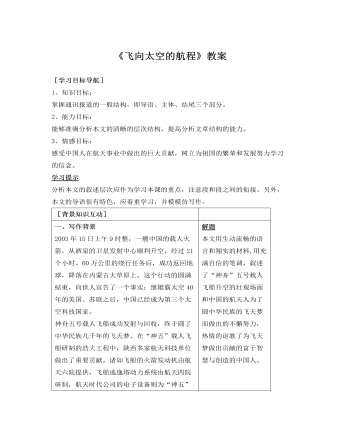
人教版高中语文《飞向太空的航程》教案
一、写作背景2003年15日上午9时整,一艘中国的载人火箭,从酒泉的卫星发射中心顺利升空,经过21个小时、60万公里的绕行任务后,成功返回地球,降落在內蒙古大草原上。这个行动的圆满結束,向世人宣告了一个事实:继雄霸太空40年的美国、苏联之后,中国已经成为第三个太空科技国家。神舟五号载人飞船成功发射与回收,终于圆了中华民族几千年的飞天梦。在“神五”载人飞船研制的浩大工程中,陕西多家航天科技单位做出了重要贡献。诸如飞船的火箭发动机由航天六院提供,飞船逃逸塔动力系统由航天四院研制,航天时代公司的电子设备则为“神五”提供了“眼睛和耳朵”……可以说,飞船的升天,可以说祖国的航天事业是千千万万献身航天科技事业的幕前幕后英雄集体智慧的结晶,正是他们共同铸就了共和国“神箭”,是他们共同托起了华夏“神舟”。二、作家作品贾永、曹智、白瑞雪,新华社记者。
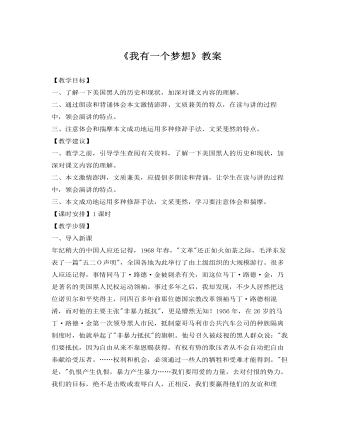
人教版高中语文《我有一个梦想》教案
一、导入新课年纪稍大的中国人应还记得,1968年春,"文革"还正如火如荼之际,毛泽东发表了一篇"五二O声明",全国各地为此举行了由上级组织的大规模游行。很多人应还记得,事情同马丁·路德·金被刺杀有关,而这位马丁·路德·金,乃是著名的美国黑人民权运动领袖。事过多年之后,我却发现,不少人居然把这位诺贝尔和平奖得主,同四百多年前那位德国宗教改革领袖马丁·路德相混淆,而对他的主要主张"非暴力抵抗",更是懵然无知!1956年,在26岁的马丁·路德·金第一次领导黑人市民,抵制蒙哥马利市公共汽车公司的种族隔离制度时,他就举起了"非暴力抵抗"的旗帜。他号召久被歧视的黑人群众说:"我们要抵抗,因为自由从来不靠恩赐获得。有权有势的欺压者从不会自动把自由奉献给受压者。……权利和机会,必须通过一些人的牺牲和受难才能得到。"但是,"仇恨产生仇恨,暴力产生暴力……我们要用爱的力量,去对付恨的势力。我们的目标,绝不是击败或羞辱白人,正相反,我们要赢得他们的友谊和理解。"
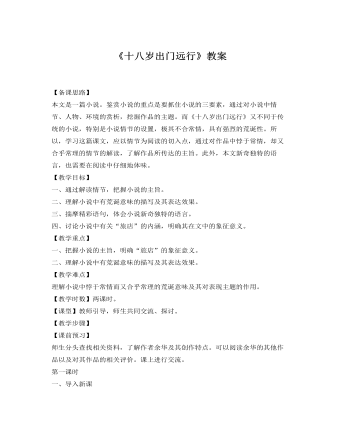
人教版高中语文《十八岁出门远行》教案
【备课思路】本文是一篇小说。鉴赏小说的重点是要抓住小说的三要素,通过对小说中情节、人物、环境的赏析,挖掘作品的主题。而《十八岁出门远行》又不同于传统的小说,特别是小说情节的设置,极其不合常情,具有强烈的荒诞性。所以,学习这篇课文,应以情节为阅读的切入点,通过对作品中悖于常情,却又合乎常理的情节的解读,了解作品所传达的主旨。此外,本文新奇独特的语言,也需要在阅读中仔细地体味。【教学目标】一、通过解读情节,把握小说的主旨。二、理解小说中有荒诞意味的描写及其表达效果。三、揣摩精彩语句,体会小说新奇独特的语言。四、讨论小说中有关“旅店”的内涵,明确其在文中的象征意义。【教学重点】一、把握小说的主旨,明确“旅店”的象征意义。二、理解小说中有荒诞意味的描写及其表达效果。
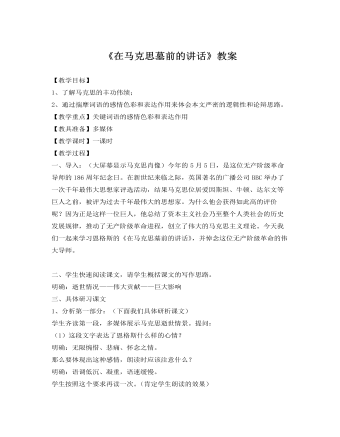
人教版高中语文《在马克思墓前的讲话》教案
【教学过程】一、导入:(大屏幕显示马克思肖像)今年的5月5日,是这位无产阶级革命导师的186周年纪念日。在新世纪来临之际,英国著名的广播公司BBC举办了一次千年最伟大思想家评选活动,结果马克思位居爱因斯坦、牛顿、达尔文等巨人之前,被评为过去千年最伟大的思想家。为什么他会获得如此高的评价呢?因为正是这样一位巨人,他总结了资本主义社会乃至整个人类社会的历史发展规律,推动了无产阶级革命进程,创立了伟大的马克思主义理论。今天我们一起来学习恩格斯的《在马克思墓前的讲话》,并悼念这位无产阶级革命的伟大导师。二、学生快速阅读课文,请学生概括课文的写作思路。明确:逝世情况——伟大贡献——巨大影响三、具体研习课文1、分析第一部分:(下面我们具体研析课文)学生齐读第一段,多媒体展示马克思逝世情景。
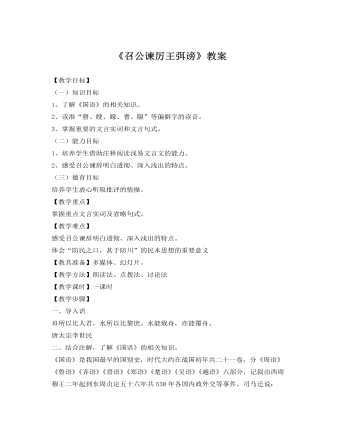
人教版高中语文《召公谏厉王弭谤》教案
六、结合讲解和译文,学生三读课文,分析内容。(一)解析第一段内容1、请找出能体现厉王性格特征的词语,说说厉王是一个什么样的人。“虐、怒、杀”暴虐凶残、残忍昏庸2、正由于厉王的行动,导致国人怎样?(从文中找出原句)谤王——道路以目3、“国人莫敢言”,是国人真的沉默无语,俯首听命了吗?没有,而是即将“在沉默中爆发”,人民在沉默中孕育着反抗,这是高压下的沉默,是火山喷发前的死寂。(二)浏览第二段本段主要是召公的谏辞。1、召公对厉王弭谤的方法有何批评?(原文)明确:是障之也。(随后用了“防民之口,甚于防川”来说明堵塞言论的危害性。并指出“为水”的最有效的办法是“导”,“为民”的最有效的办法是“宣”。)2、古代天子听政如何广开言路?明确:直接的:①使公卿至于列士献诗,②瞽献曲,③史献书,④师箴,⑤瞍赋,⑥曚诵,⑦百工谏。
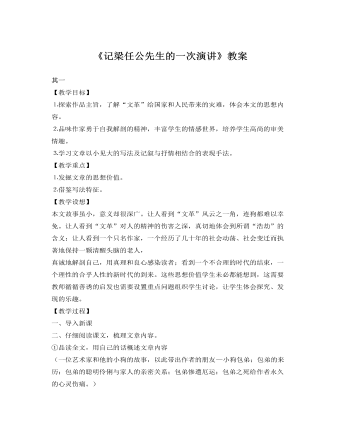
人教版高中语文《记梁任公先生的一次演讲》教案
十、教学后记:这是我实习中上的第一堂课,由于没有经验,对时间的把握不好,课堂前半部分留给学生思考回答问题的时间太多了,以至于没有完成本课时的教学内容,对《箜篌引》、《桃花扇》、《闻官军收河南河北》内容的补充要留到下节课才能完成。但课堂过程中以讨论和结果发布会的形式非常能调动学生的学习积极性,这节课学生的参与度很高,绝大部分的同学都能积极思考,并敢于回答问题。但是在学生回答问题后,有些答案很好,也是我没有思考到的。但是除了简单的表扬鼓励外,我不善于把学生的思考结果与自己的板书设计结合起来,授课过程中比较拘泥于教案,显得不够灵活。总的来说,这节课的优点是教态自然、大方,声音清晰洪亮,能调动学生学习的积极性,不足在于时间掌握不好,拘泥于教案。
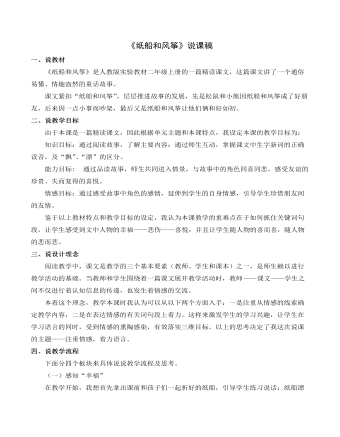
《纸船和风筝》说课稿
研读第三段。(出示第三段)首先我深情地描述第一、二段的文本内容自然而有情境地引入第三段。先是学生齐读完第三段后,接着老师发问,小熊拿到纸船,乐坏了,他乐得。让学生看图自己说说。二年级的孩子词汇量比较缺乏,我会为给他们搭好台阶,送给他们一些词语,比如手舞足蹈、眉开眼笑、兴高采烈、喜笑颜开……来丰富他们说话的内容。
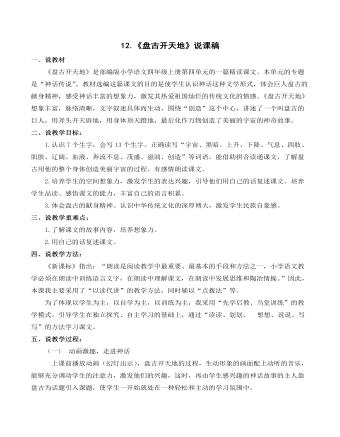
《盘古开天地》说课稿
特级教师于永正说过:“正确的读书方法不是盲目地读,要读得有层次,读得有目的。”遵循这个指导思想,这里我设计了三个层次的朗读,抓住“抡斧猛劈”、“缓缓”、“慢慢”等词,让学生通过自由朗读,个性阅读,体验阅读,从字词读到内容读再到感情读,层层递进,环环紧扣,使学生在品读中明白宇宙成形时天与地的不同,体会盘古开天辟地的艰难和决心。
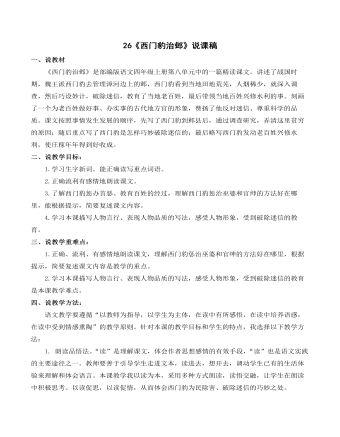
《西门豹治邺》说课稿
引导入境体会:这一天,漳河站满了老百姓,设想一下,岸上的人们看了事情的经过会说些什么?请你选择一个你感兴趣的对象说一说,然后写下来。(官绅、乡里的书生、老百姓、小孩,你可以写一个,也可以写两个,可以写一句,也可以写几句)
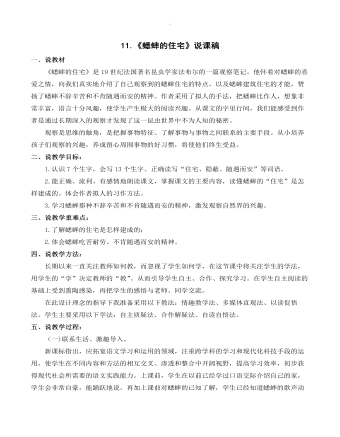
《蟋蟀的住宅》说课稿
这样先让学生自读自悟,再在小组讨论交流,就真正达到人人动口读书,用心体验,实现人人自主学习,而不让小组合作学习成为个别优秀学生的一言堂,从而提高小组合作、探究学习的效率。达到设计理念中引导学生自主、合作、探究学习,培养学生自主、合作、探究学习的能力。

